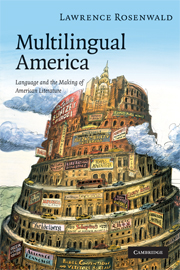Book contents
- Frontmatter
- Contents
- Preface
- Acknowledgments
- Introduction: techniques, methods, theses
- Chapter 1 Cooper's The Last of the Mohicans and the languages of America
- Chapter 2 Alfred Mercier, George W. Cable, and Louisiana French Creole
- Chapter 3 More than an echo, or, English in Yiddish in America
- Chapter 4 “New language fun,” or, on translating multilingual American texts
- Chapter 5 Towards a history of multilingual American literature
- Bibliography
- Index
Chapter 5 - Towards a history of multilingual American literature
Published online by Cambridge University Press: 22 September 2009
- Frontmatter
- Contents
- Preface
- Acknowledgments
- Introduction: techniques, methods, theses
- Chapter 1 Cooper's The Last of the Mohicans and the languages of America
- Chapter 2 Alfred Mercier, George W. Cable, and Louisiana French Creole
- Chapter 3 More than an echo, or, English in Yiddish in America
- Chapter 4 “New language fun,” or, on translating multilingual American texts
- Chapter 5 Towards a history of multilingual American literature
- Bibliography
- Index
Summary
Given the multilingualism of so many national literatures, including American literature … one can no longer assume that the categories of national literature and literature in a given language are at all compatible.
– Reed Way DasenbrookIt's been forty-one years that I’ve lived between your borders, America, and have carried within me the fruits of your freedom consecrated and blessed by the sacrificial blood of Lincoln and the hymns of Walt Whitman.
– from the Yiddish of H. Leivick, trans. Richard FeinFor non-anglophone language fictions to matter they need to be widely read, and to be widely read they need to be translated – hence the previous chapter. But once translated, once widely read, they need to be made part of the large narratives we construct of our literary history. To make that happen, we have to figure out how to write the single history of a literature created in multiple languages.
The present chapter is meant to aid in that task. It states the reasons for undertaking it, assesses what some of the comprehensive histories of American literature have done in this area, sketches one alternative approach, and concludes with an image of utopian hope.
WHY?
A comprehensive history of American literature needs to take account of American literature written in languages other than English.
- Type
- Chapter
- Information
- Multilingual AmericaLanguage and the Making of American Literature, pp. 146 - 159Publisher: Cambridge University PressPrint publication year: 2008



